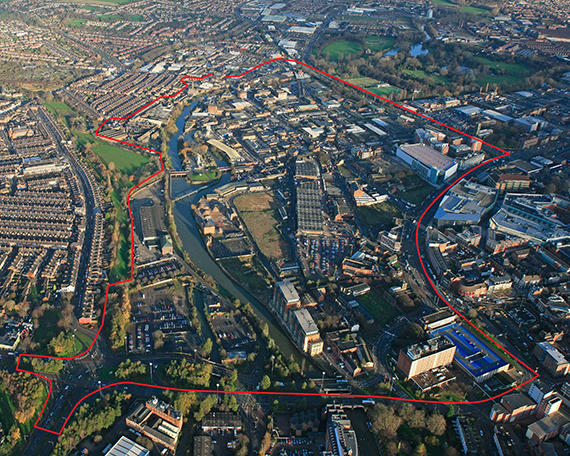
The East Midlands is enthusiastically embracing private rented sector (PRS) development. Leicester is the latest location to announce plans, following on from schemes mooted in Nottingham and other regional cities.
Leicester city council has been buoyed by this summer’s approval of its local development plan. The authority wants a 250-unit PRS element within 500 homes proposed for the first phase of its Waterside regeneration project. This is on a 13-acre former industrial site north-west of the city centre, opposite Hammerson’s Highcross shopping centre and including parts of the River Soar and the Grand Union Canal.
“PRS is the right fit here,” says the council’s Waterside project manager, David Beale. “It will unlock substantial future housing for the site and it has the appropriate demographic to fulfil our plans to create an aspirational, young and professional neighbourhood.”
Leicester council is now soft-launching Waterside by having early-stage discussions with interested funds. Beale says these would-be investors have contacted him, rather than the other way round, and are seeking PRS prospects across the city, not just at this scheme.
“They all have the same approach,” he says. “London’s too competitive for PRS now and set-up costs are pretty high, with more risk. Leicester looks like a more interesting prospect.”
Unlike some cities, PRS Leicester-style is set to be low-rise. Waterside’s plans are for a maximum of six-storey blocks – and it is not looking for student take-up. “There has been a substantial delivery of student accommodation in the city in the past year and that market isn’t far from saturation point,” explains Beale.
Leading the PRS charge in the region, however, is Nottingham, where construction on 350 units from Godwin Developments will start in January – the city’s first PRS scheme to break ground.
Godwin director Stephen Pratt says the 1.75-acre Hicking Pentecost site, formerly a bleach and dying factory, was selected because of its appropriateness for high-density construction and its location as a “gateway” near, but not in, the city centre.
For Pratt, however, a student market is influential and he favours Nottingham because of its student population – well over 60,000. With long-term steady rental yields and relatively low land values, it is a combination that makes the area ripe for PRS, he says.
“If you compare rents between Birmingham and Nottingham, say, there’s not a big difference. But site prices are very different and it’s those lower site values that make the East Midlands a sound bet for PRS,” says Pratt, whose firm is also looking at locations in Leicester, Derby and Coventry – although no firm deals have yet been signed.
“We are talking to about 12 funds on the subject of PRS and they are coming to us, more than the other way around. That’s a sign that the region is considered a good investment,” he says.
Michael Donaghy of Savills in Nottingham – which handled the Hicking Pentecost sale to Godwin – says the region’s councils are busy, too. “Local authorities are being proactive, promoting land and having discussions with PRS operators,” he says.
Donaghy says that, among the developers, UK Regeneration is looking at a possible 200-plus unit scheme in Nottingham, while Admiral House Property, Trading, William Pears Group and Metro Property are among those in discussions about smaller 25- to 200-unit proposals across the region.
Sites known to be under consideration for PRS include Springfield Mill in Sandiacre on the Nottingham/Derby border – which has been under discussion for some time. In addition, the 20-acre former Derby Royal Infirmary site and the Picture Works and Marco Island sites in Nottingham are being widely discussed for development potential.
This paints a picture of what is arguably a more thriving potential PRS in the East Midlands than has been suggested in the past.
Two years ago a report jointly produced by consultancies Hometrack and EJ Harris, called Pushing the boundaries, identified criteria for regional PRS feasibility – including land values, delivery costs and rental demand for notional two-bedroom units. The East Midlands was considered a challenging region for investors, although its viability improved if unit sizes were reduced, leading to a cut in construction costs.
“It’s still a challenging region compared to some others, although where wages and rental demand are strong and there are key employers – Rolls-Royce in Derby, for example – investors will be attracted,” says EJ Harris’ Mark Farmer, one of the report’s authors.
New figures from RBS shows the East Midlands economy growing 2.7% in the past year, comparable with south-east England and higher than East Anglia and Yorkshire.
Perhaps that, and the increasingly crowded PRS marketplace in London, will make the East Midlands a go-to location. It’s beginning to look that way.
Wider residential landscape
A report released in August by the Home Builders Federation suggests 13,190 East Midlands homes were started by private housebuilders, the public sector and housing associations in 2014 – a shortfall of 1,793 homes on the basis of household growth.
There may be light at the end of the tunnel. “Apartment schemes, which were not previously being developed, are now coming forward and previously non-viable sites are now viable again,” says Michael Donaghy of Savills.
Both Nottingham and Leicester have seen some office-to-resi conversions under Permitted Development Rights – in both cities the units have been used as student accommodation.











